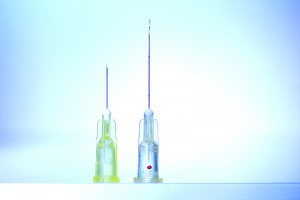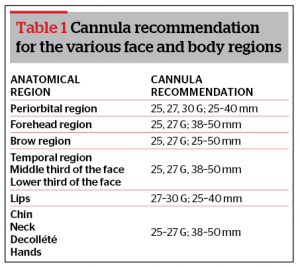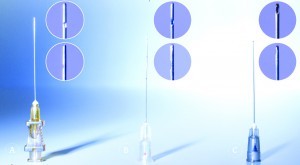Cannula labelling
Manufacturers have begun to label cannulae with ‘TW’, which refers to ‘Thin Wall’. The TW cannula has an increased inner diameter (improved from the standard internal diameter), which allows for a faster flow rate. Such cannulae are much easier to use, especially when injecting high viscosity material. Irrespective of the manufacturer, product flow is determined by both the internal diameter (not gauge) and the length of a cannula.
In October 2012, TSK Laboratory released a cannula model called STERiGLIDE. It is labelled ‘UTW’, referring to ‘Ultra Thin Wall’. It has the largest inner diameter and to date. The STERiGLIDE comes with an introducer needle that can be used to create the entry hole for the cannula. SoftFil also launched a new cannula model called the Precision XL, which has an ‘Extra Thin Wall’. It also comes with an introducer needle and continues to offer its traditional model, the Classic L (‘Thin Wall’). Sterimedix launched a new cannula model called the Silkann UTW, which also comes with a needle.
Cannula gauge
Cannulae are available in a variety of gauges, and it is extremely important to find the right gauge for each treatment area.
The smallest cannula gauge is 30 G. In the author’s opinion, this size is not very convenient to work with for the following reasons:
- The cannula is thin, and therefore it can bend easily, meaning that it is difficult to monitor its precise location within the treatment area
- The chance of penetrating and traumatising the vessels and nerves is higher than with cannulae of a larger gauge, being close to that of a regular needle
- There is a greater chance of cannula breakage, including an area of the side port.
The largest cannula gauge is 22 G, but some manufacturers offer even 18 G cannulae. As it is so large, pressure on the plunger is much more difficult to control, and therefore the material comes out too quickly, preventing an efficient use of the product.
Cannulae in the middle range of gauge — 27 G and 25 G — are the most universal and efficient, as they combine precision, strength, and flexibility, and in principle can be used to inject high-viscosity solutions. The author finds that these are the ‘workhorses’ among the available cannulae.
Cannula length
Cannula length is another important aspect when choosing the right one to use (Figure 2). Working with the shortest range of cannulae, 19–25 mm (30 G or 27 G), is not very convenient for the following reasons:
- They are not much longer than a needle, therefore the range of movement is restricted
- Short cannulae can only treat a small area and require more injection points, which places an additional burden on the doctor–patient relationship, increases procedure time, and reduces the aesthetic benefits owing to an increased risk of bruising.
Therefore, the middle length cannulae, of 38–40 mm or 50 mm, are the most practical, as they are long enough to treat an area with a single injection point, but not too long when it becomes difficult to control the accuracy.
The latter range of length (38 and 50 mm) is the length that the author prefers to use for rejuvenation procedures, applying his personally developed technique using STERiGLIDE (TSK Laboratory) cannulae for treatment of the face, chin, neck, decollété, and hands.
Table 1 shows the recommended cannulae for each specific anatomic region.

Figure 2 Comparing lengths of a needle and a cannula 30 G. (Left) needle 30 G x 13 mm; (Right) cannula 30 G x 25 mm
Cannula configuration and its bundling
The location of the port on the cannula is very important. The closer the port is to the end of the cannula, the more precise the injection, and the less likely the cannula is to break. As the area of the port is the thinnest and most vulnerable, it is here that breakage is most likely to occur. Among the various cannulae, the STERiGLIDE, Silkann, and Mesotech have the closest port to the tip, with the least chance for breakage (Figure 3).
With thicker cannulae, this becomes less relevant, but when working with cannulae with gauges of 30 G and 27 G, the possibility of breakage must be considered. With thin cannulae that can bend easily, the likelihood of breaking is greater at the cannula’s base. Therefore, working with thin cannulae must be performed with extreme care. The side port indication mark is on its hub and allows the user to track the position of the side port in the tissue during the procedure (e.g. STERiGLIDE, SoftFil Precision and Silkann cannulae) (Figure 4).
A ribbed cap makes its removal easier, while a smooth cap can make it difficult to remove with wet gloves (Figure 5). TSK Laboratory introduced a new tip design and surface treatment, allowing for better penetration in the entry hole and a significantly-improved gliding characteristic when directing the cannula in different directions (Figure 3c).





